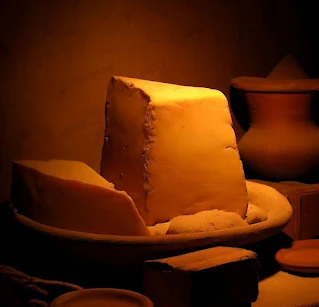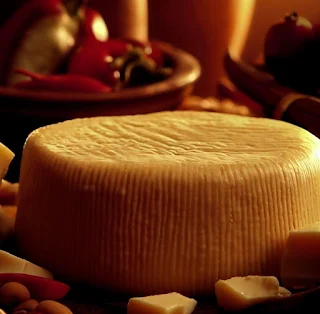Ancient Egyptian Cheesemaking to Honor the Deceased
Throughout history Ancient Egypt culturally valued cheese makers and the cheese-making process.
The origin of cheese making is ancient and not precisely known. Early humans were resourceful and curious about food preparation.
The origin of cheese making is an ancient practice, and while the exact time and place of its discovery remain uncertain, it is clear that early humans were curious and resourceful when it came to food preparation. The process of cheese-making likely emerged through a combination of accidental observations and experimentation by these early humans.
Imagine ancient communities that depended on milk as a valuable source of nutrition. In their quest to find ways to preserve and make the most of this precious resource, early humans stored milk in various containers, including bags made from animal hides, while on the move in regions like Ancient Egypt with nomadic and semi-nomadic lifestyles.
The constant movement and exposure to the heat of the environment could have led to the natural curdling of the milk. Over time, these early humans would have noticed the transformation of liquid milk into solid curds and liquid whey.
Intrigued by this process, they might have tasted the resulting solid curds and discovered that they were not only edible but also had a different flavor and texture compared to fresh milk. This accidental observation likely sparked their curiosity, leading them to explore and experiment further with the process of curdling milk.
Early humans would have tested different techniques, trying various substances or natural enzymes to encourage curdling. Through trial and error, they honed their cheese-making skills, developing methods to curdle milk intentionally and refining the process to create different types of cheese. Over time, these knowledge and skills spread from one community to another, contributing to the development of cheese-making traditions across various regions and cultures.
There is a lack of written records on cheesemaking from ancient Egypt but cheese and the evidence of cheesemaking in the form of artifacts did.
Many ancient Egyptian written records were made on papyrus, which is a plant-based material. Papyrus is susceptible to decay and deterioration over time, especially in the humid and arid conditions of Egypt.
As a result, much of the written documentation on various subjects, including cheesemaking, might not have survived to the present day. Cheesemaking in ancient Egypt dates back to around 2000 BC; Egyptian cheesemaking is depicted in tomb murals from approximately 2000 BC. These murals provide valuable visual insights into the cheese-making process during ancient times.
One of the most famous examples of such a mural is from the tomb of Ti, also known as the Mastaba of Ti, in Saqqara, Egypt. Ti was an Egyptian high official during the 5th Dynasty of the Old Kingdom. In his tomb, there is a scene that shows various agricultural and food production activities, including cheesemaking.
The survival of organic material, such as cheese or evidence of cheesemaking in the form of residues or artifacts, can be attributed to favorable preservation conditions. Certain archaeological sites, particularly in desert environments, can preserve organic material exceptionally well.
For instance, the dry climate of Egypt, combined with the sealing properties of tombs, helped in the preservation of organic residues found in pottery or other containers that were used in cheesemaking.
The discovery of this cheesemaking scene has contributed significantly to our understanding of the importance of dairy products in ancient Egyptian cuisine and their sophisticated food processing techniques.
Climate in 2000 bc Egypt for herding and milking cattle for cheese-making
Some cattle herding practices in ancient Egypt were nomadic or transhumant in nature. Nomadic herding involved moving cattle to different grazing areas in search of fresh pasture, while transhumant herding involved seasonal migration between higher and lower elevations to take advantage of different grazing opportunities.
The climate of ancient Egypt, with its warm temperatures, reliable water source, and fertile land, provided favorable conditions for cattle herding and milking. Cattle were a valuable resource in ancient Egyptian society, providing not only milk but also meat, leather, and labor for agricultural tasks.
The annual flooding of the Nile River deposited nutrient-rich silt on the floodplain, creating fertile pastureland for grazing animals. This abundant vegetation would have provided ample food for cattle, making it possible for them to produce milk for cheese-making.
Ancient Egyptians were buried with food and in some cases cheese
In ancient Egyptian burial practices, it was customary to include various items and offerings that were believed to assist the deceased in the afterlife. In ancient Egypt, cheese making was a significant craft practiced by skilled artisans known as sewet.
These cheese makers held an essential role in society, as cheese was a staple food item and a valuable source of nutrition. The process of cheese-making required expertise and knowledge of various techniques to curdle and preserve milk.
The sewet were responsible for processing milk from various domesticated animals, such as cows, sheep, and goats, into different types of cheese. They would have been part of the workforce or skilled laborers in the agricultural and food production sectors of ancient Egyptian society.
The ancient Egyptians had a strong belief in an afterlife, and they thought that the deceased would continue to exist in a realm similar to the earthly one. To ensure a smooth transition to the afterlife and provide for the needs of the sewet deceased in the hereafter, tombs were filled with a variety of objects, food, and personal possessions to continue making cheese in the afterlife.
These offerings, known as funerary or burial goods, were intended to provide sustenance, comfort, and enjoyment in the afterlife. Common items included food, water, clothing, furniture, jewelry, and personal belongings. The specific items included in tombs could vary based on the individual's social status, wealth, occupation, and beliefs.
Offerings of bread, beer, wine, meat, fruits, vegetables, and in some cases other foodstuffs such as cheese were common, as they were considered essential for the nourishment and pleasure of the deceased in the afterlife.








